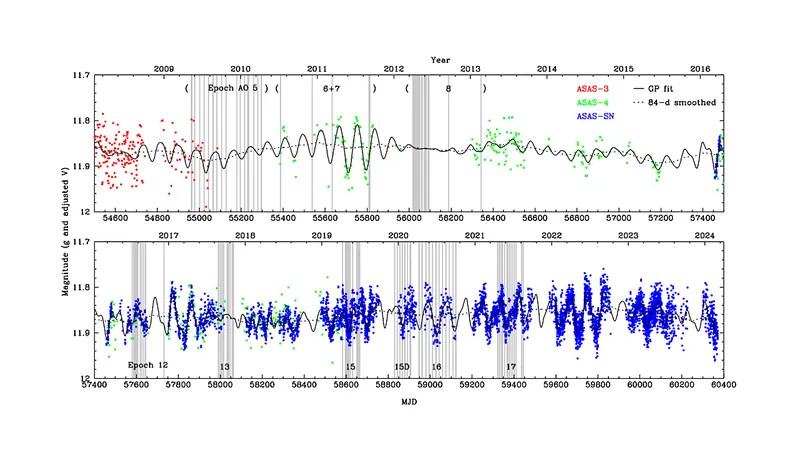
Unveiling the Stellar Rhythm of Proxima Centauri: A Groundbreaking Study
2024-11-08
Author: Jacques
In an exciting new study published on November 5, 2024, astronomers have made significant strides in understanding the stellar cycle of Proxima Centauri, known scientifically as GJ 551, a fully convective star that has captured the attention of the astrophysical community. This research showcases Proxima Centauri as the only star with long-term X-ray monitoring and provides critical insights into its behavior over an impressive time span.
The research builds upon previous analyses which suggested correlations between X-ray and mid-ultraviolet (UV) observations. Earlier studies utilized data from NASA's Swift satellite and suggested that these observations were in harmony with a 7-year optical cycle identified in ASAS data. However, lacking comprehensive data, these findings were not definitive.
Now, incorporating several years of new optical data from the ASAS-SN (All-Sky Automated Survey for Supernovae) project alongside five years of Swift observations, which cover 2009 to 2021, this study offers a much-needed breakthrough. Additionally, X-ray data from the XMM-Newton and Chandra observatories enrich the dataset, allowing researchers to paint a clearer picture of Proxima Centauri's stellar behavior.
Through meticulous analysis of the compiled data—which has been adjusted for stellar contamination in both optical and UV observations—the study reveals a pronounced cyclic behavior that spans all three wavelengths with a newly identified period of 8.0 years. This discovery suggests a more complex and dynamic environment around Proxima Centauri than previously understood.
Moreover, the researchers uncovered important relationships between UV and X-ray emissions, noting that these intensities appeared to be anti-correlated with optical brightness, strongly influenced by both the stellar cycle and rotational modulation. Two potential coronal mass ejections were also indicated in the findings, hinting at significant magnetic activities occurring on the star.
The team, comprised of notable scholars in the field including B.J. Wargelin and S.H. Saar, also revisited the previous correlation between the amplitude of X-ray cycles and the Rossby number—a dimensionless quantity used to measure the influence of rotation on a star—expanding our understanding of these relationships across various stellar types and ages.
This comprehensive study not only highlights the beauty of Proxima Centauri's cyclical nature but also lays a foundation for future research into stellar behavior and its implications on planetary science, especially given Proxima Centauri's status as the nearest known star to the Sun. As research in this domain continues to unfold, astronomers remain eager to further decipher the complex interactions in the cosmos, with implications that could even touch upon the prospects of life beyond our solar system.
Stay tuned for further insights from this groundbreaking research and more discoveries that await in the intriguing world of stellar astrophysics!









 Brasil (PT)
Brasil (PT)
 Canada (EN)
Canada (EN)
 Chile (ES)
Chile (ES)
 España (ES)
España (ES)
 France (FR)
France (FR)
 Hong Kong (EN)
Hong Kong (EN)
 Italia (IT)
Italia (IT)
 日本 (JA)
日本 (JA)
 Magyarország (HU)
Magyarország (HU)
 Norge (NO)
Norge (NO)
 Polska (PL)
Polska (PL)
 Schweiz (DE)
Schweiz (DE)
 Singapore (EN)
Singapore (EN)
 Sverige (SV)
Sverige (SV)
 Suomi (FI)
Suomi (FI)
 Türkiye (TR)
Türkiye (TR)